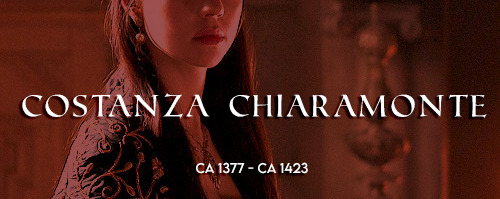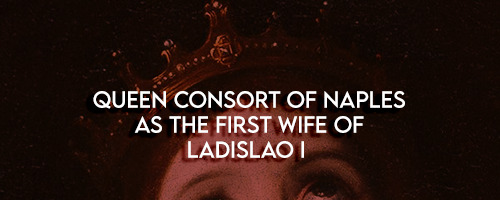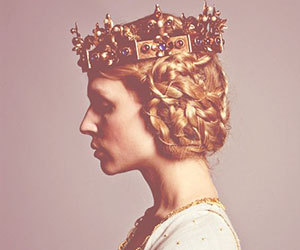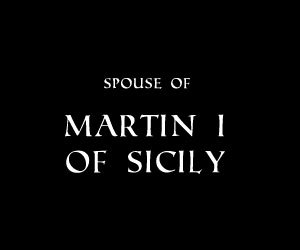#manfredi iii chiaramonte
Explore tagged Tumblr posts
Photo




“But it happened that some merchants from Gaeta, who had gone to Sicily to buy grain, spoke in front of the Queen about the riches of Manfredi Chiaramonte, and about the beauty of a daughter of his. Whence the Queen's wandering mind stopped to think to ask for the girl's hand on behalf of her son, the King Ladislao, who was already fourteen [sic] years old.”
in Angelo Di Costanzo, Historia del Regno di Napoli dell'Ill. Signor Angelo di Costanzo, Gentil’huomo e Cavaliere Napolitano, p. 237 [my translation]
Costanza was born around 1377 (probably in Palermo) from the noble and ancient family of Chiaramonte. She was the daughter of Manfredi III Chiramonte, IX Earl of Modica and Duke of Malta, and his wife, Eufemia Ventimiglia. Costanza's father was a powerful man, who, during his lifetime, would hold high profile roles, such as Admiral, Grand Seneschal, Master Justiciar and Regent of the Kingdom for young Queen Maria of Sicily. From her mother side, she was the granddaughter of another former Regent, Francesco II Ventimiglia, Earl of Geraci.
In 1389 Margherita of Durazzo, Regent of the Kingdom of Naples, asked fellow Regent Manfredi Chiaramonte for Costanza's hand on behalf of her son, the twelve years old Ladislao of Anjou-Durazzo. Three years prior, after his father Carlo III had been murdered, Ladislao failed to be recognized by Urban VI as legitimate King of Naples. The Pope had assigned the throne to Louis II of Anjou, whose father had previously (in 1380) been adopted as son and heir by the childless Queen Giovanna I of Anjou-Naples in an attempt to block the rival Anjou-Durazzo's claims to the Neapolitan throne. In 1387 Louis II's troops invaded the Kingdom of Naples, so young Ladislao, alongside his mother, the rest of the family and court, was forced to seek refuge in Gaeta.
If the Chiaramontes' social status benefited from the newly acquired (although wobbly) royal connections, the Anjou-Durazzo made good use of the bride's rich dowry to replenish their worn-out coffers. Their economic situation was so dire, the University of Gaeta had to act as a guarantor and advance the sum of 15 thousand gold florins on behalf of the royal family, which would have been handed to the bride's family in case of non-consummation of the marriage and consequent dissolution of the union. In summer 1389 Costanza then arrived in Gaeta by sea escorted by galleys. These same vessels managed successfully to break the chains which locked Naples' harbour and bring relief to the Durazzo forces besieged in Castelnuovo.
In October of the same year, one of Ladislao' enemies, Urban VI died. Unlike his predecessor, Boniface IX favoured the Durazzos since the Anjou supported the Antipope Clement VII. As also the Chiaramonte backed the newly elected Pontiff, the union between Ladislao and Costanza received Clement's blessing. The marriage between the now recognized King of Naples and the Sicilian noblewoman (they were both 13 years old) finally took place on August 15th 1390 (the marriage settlement probably dated back to September of the previous year). The religious ceremony was immediately followed by a joint crowning ceremony.
This union would prove to be short-lived as Chiaramontes' fortunes were about to change. Costanza's father, Manfredi died in 1391 and was succeeded by his kinsman, Andrea Chiaramonte, X Earl of Modica. That same year, Queen Maria married her second cousin Martino the Younger of Aragon. In the eyes of the majority of the Sicilian nobles, Martino was a stranger (despite being, like his wife, a descendant of Pietro II of Sicily) and his marriage to the Queen could (and would) have led to Sicily fall under a more direct control of the House of Aragon, with the consequent loss of influence of the Sicilian nobility. In the end, Andrea Chiaramonte was abandoned by his allies and found himself alone in trying to contrast the new King consort and his father, the powerful Infante Martino, Duke of Montblanc (and later King of Aragon and Sicily). The Earl of Modica was arrested, charged with treason and beheaded in Palermo, June 1st 1392.
With the decline of her family, the young Queen of Naples' fortunes too deteriorated. The King had now no reason to be still married with the representative of a disgraced household. In May of the same year, Ladislao had travelled to Rome to obtain from the Pope the annulment of the marriage. The official motivation was the minority of the bride and groom. To make things worse, the Queen's mother, Eufemia Ventimiglia, was accused of debauchery and to have become Infante Martino's mistress.
In July 1392, the Pope conceded Ladislao the desired annulment, and the bill of divorce was read publically by the Bishop of Gaeta while the King and Queen were attending mass. The Bishop pulled the wedding ring from Costanza's hand and handed it back to Ladislao.
Three years later, the King married his former wife to one of his vassals, Andrea di Capua, IV Earl of Altavilla (1374-1399). Costanza's modest dowry amounted to 3 thousand ducats. According to tradition, she publically and disdainfully addressed her new husband telling him he could now brag he could call as his concubine his King's wife. Costanza bore Andrea di Capua at least one son, Luigi (1400-1443), who will inherit his father's titles and possessions. Costanza died in 1423 and is currently buried in the Church of the Madonna delle Grazie, in Riccia (n the region of Molise), together with her husband, son and the rest of the di Capua's members.
As for Ladislao, in 1403 he would marry Maria of Lusignan, Princess of Cyprus and Jerusalem, but the new Queen would die the following year. In 1406 he would marry a third and last time, with Maria of Enghien, widow of Raimondo Orsini del Balzo, Prince of Taranto. The King of Naples would die 8 years later without legitimate children and the crown would be inherited by his sister Giovanna II.
Sources
- Salvatore Fodale, COSTANZA Chiaramonte, regina di Napoli in Dizionario Biografico degli Italiani
- Angelo Di Costanzo, Historia del Regno di Napoli dell'Ill. Signor Angelo di Costanzo, Gentil’huomo e Cavaliere Napolitano
- Famiglia di Capua
#history#women#history of women#women in history#historical women#costanza chiaramonte#ladislao i#manfredi iii chiaramonte#chiaramonte#aragonese-spanish sicily#people of sicily#women of sicily#myedit#historyedit
66 notes
·
View notes
Photo

Palazzo Chiaramonte - Steri. Palermo, XIV secolo. In stile gotico - Chiaramontano, il palazzo fu la grande dimora di Manfredi I Chiaramonte ed emblema dall'ascesa di questa potente e nobile famiglia siciliana alla guida de factum del Regno di Sicilia nel corso del Trecento. Oltre ad ospitare, dal Cinquecento, i Vicerè spagnoli, il Palazzo Chiaramonte - Steri fu sede del Tribunale dell'Inquisizione di Sicilia dal 1600 al 1782, e delle spaventose Carceri dei Penitenziati, istituite da Filippo III nei primi anni del Seicento, tristemente noto per le celle delle segrete, buie, fredde e umide, e in particolare per le cosiddette celle perpetue, destinate ai condannati in isolamento, dove ancora oggi è possibile osservare i suggestivi e tristi graffiti dei condannati dall'Inquisizione per stregoneria o reati gravi come bestemmia, sodomia, eresia. Fu oggetto di un restauro negli anni Cinquanta del Novecento, molto contestato poiché eliminò diverse testimonianze artistiche dell'opera poiché si collegavano al periodo inquisitorio. I graffiti furono, fortunatamente, scoperti e salvati grazie all'opera dell'esperto storico Giuseppe Pitrè, che li riportò alla luce e analizzò con cura. Dal 1950 è sede del Rettorato dell'Università degli studi di Palermo. #palazzochiaramontesteri #palazzosteri #goticochiaramontano #palermomedievale (presso Palazzo Chiaramonte-Steri) https://www.instagram.com/p/CPjwhOPlYHqbNLmKzGf7kWuYLHouku9ytrZ1po0/?utm_medium=tumblr
0 notes
Photo










Maria was born in Catania on July 2nd 1363. Her father was Frederick III (or IV) the Simple, King of Trinacria and Duke of Athens and Neopatras. Her mother, Constance of Aragon (firstborn of Peter IV King of Aragon and his first wife Maria of Navarre) died in childbirth. After Constance’s death, Frederick married Antonia of Baux, sister of the last Latin Emperor of Constantinople James of Baux. Antonia died childless in 1374 after only two years of marriage. Frederick never remarried and when he died in 1377 his sole legitimate heir was his 14 old daughter, Maria, notwithstanding the provisions of Frederick II (III) which forbidden female heirs to succeed. In his will, Frederick III arranged that in case Maria would have died without heirs, the crown would have passed to the House of Aragon. To his bastard son William, Frederick left the islands of Malta and Gozo.
Because of her young age, but mainly since she was female, Maria wasn’t free to rule by herself. Her godfather and legal guardian, Artale I Alagona earl of Mistretta and Lord of Paternò, assumed the regency but was soon forced to form a government with three other Vicars whom belonged to the most influential families (Francesco II Ventimiglia earl of Geraci, Manfredi III Chiaramonte earl of Modica and Guglielmo Peralta earl of Caltabellotta). The main purpose of this council would have been to ensure good governance and balance between the Latin faction and the rival Catalan faction. De facto each one of the four noblemen ruled over a part of the island, while Maria was queen in name only and lived in semi-liberty in Castello Ursino in Catania, under the protection of her godfather.
When it came the time to find her a husband, Artale planned to marry the young queen to the duke of Milan, Gian Galeazzo Visconti. The Vicar’s hidden plan was to rule over all Sicily once his goddaughter would have left the island to live with her husband. Unfortunately for him, on the night of January 23rd 1379 Maria was kidnapped by Guglielmo Raimondo Moncada earl of Agosta. Moncada was supported by Peter IV of Aragon, who was against the Milanese marriage plan since he would have lost his claims over Sicily if his granddaughter were to marry the Duke Visconti. The King of Aragon took charge of the government of the Kingdom of Trinacria and sent his son Martin the Older Duke of Montblanc to Sicily to act as a Viceroy. Martin was not only Maria’s uncle, but was also her first cousin since Martin’s mother was Eleanor of Sicily, Frederick III’s older sister.
Maria was escorted to the castle of Augusta (modern-day province of Siracusa), but soon the castle was put under siege by Artale of Alagona who intended to retrieve his goddaughter. Maria was then moved to the castle of Licata. In the meantime Peter IV arranged the marriage of the queen with another one of his grandsons, Martin the Younger. The marriage contract was signed on July 24th 1380 by the King of Aragon, the groom’s father Martin the Older, Guglielmo Raimondo Moncada and Enrico Rosso earl of Aidone. Since the Artale wouldn’t give up, Maria was sent to Sardinia and later to Barcelona. In 1388 she was moved to Terrasa because at that moment Barcelona was striken by plague. Since leaving Sicily, she never lived according to her status but in isolation and tight budget. Under the regency of her grandfather, Maria lost the duchies of Athene and Neopatras. After being run by the Aragonese, in 1381 the Florentine aristocrat Nerio Acciaioli occupied Athens and in 1390 Neopatras.
In 1387 Peter IV died and was succeeded by his son John I. Like his younger brother, Martin the Older, John was the son of Peter IV and Eleanor of Sicily. In 1391 in Barcelona Maria finally married her cousin Martin, who would have ruled along with his wife as Martin I. Since the bride and groom were blood relatives, the needed a papal dispensation. The approval was granted by Antipope Clemens VII, whom the House of Aragon decided to support during the matter of the Papal Schism. In the eyes of the Sicilian nobles Martin was seen as a usurper. On July 10th 1391, the four Vicars met in the Church of St. Peter in Castronovo di Sicilia (modern-day province of Palermo) and pledged their loyalty to the queen, but rejected Martin. A similar oath was taken at the beginning of the same year in the castle of Mussomeli, property of the Chiaramonte family. They were backed by Pope Boniface IX who entrusted them of the rule of the island. The Vicars also appealed for the help of King Ladislaus of Naples and Gian Galeazzo Visconti of Milan. Surprisingly this oath was short-lived since Ventimiglia, Alagona and Peralta would later welcome with open arms the queen and her husband.
On March 22nd 1390, Maria along with her husband and father-in-law landed in the island of Favignana (near Trapani) and then proceeded to Palermo, which was conquered. Maria and Martin were finally crowned in Palermo’s Cathedral and after putting to death the rebel Andrea Chiaramonte (successor of Manfredi III), they continued their campaign to re-conquer Sicily. They freed Catania, then Messina and had to go back to Catania which was occupied once again by the rebels. Maria chose to settle in the Castello Ursino, which once had been her first gilded cage. In 1396 John I of Aragon died and Martin the Older had to go back to Spain to succeed his brother. The departure of her father-in-law stressed so much Maria to the point she fell into depression and became ill. She would be treated by many physicians (among them Josef Abenafia) and being poor of health for a whole year.
On November 17th 1398, two and half in the morning, the queen gave birth to her only son and heir. Despite his mother chose for the baby the name Frederick (after his maternal grandfather), the baby was christened as Peter, to honour King Peter IV, on April 23rd 1399. Maria’s happiness wouldn’t last long. On November 8th 1400 Peter was accidentally hit by a spear during a tournament and died, causing the queen to fall into despair.
When Catania was stricken by the plague, it was disposed to transfer Maria to a safer place. The measure proved to be ineffective since Maria caught the plague and died (alone as she had lived) in the castle of Lentini (modern-day province of Siracusa) on May 25th 1401. She was buried in Catania’s Cathedral, the same place where her mother and son rested. At the news of her death, her father-in-law ordered that every court, cathedral and city of Aragon should commemorate the late queen. After Maria’s death, her husband Martin I became the only sovereign and the year after married Blanche of Navarre.
#women#women history#historical women#history#sicily#maria of sicily#frederick iii of sicily#constance of aragon#martin i of sicily#martin ii of sicily#aragonese-spanish sicily#people of sicily#women of sicily#myedit#historyedit#house of aragon and sicily
44 notes
·
View notes